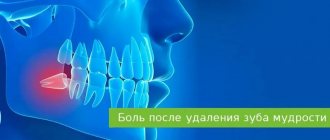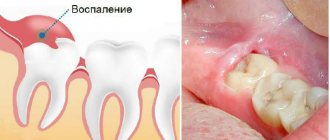Pain after tooth extraction (extraction) is a normal reaction of the body to injury to the gums or mucous membrane. It goes away on its own in an average of 2-3 days. Increased pain, swelling and fever may indicate the development of an inflammatory or infectious process. In this case, you must contact your dentist to prescribe treatment.
Pain after tooth extraction
After the tooth is removed and the anesthesia wears off, the patient may experience minor pain, which usually goes away quickly. However, sometimes 1-3 days after surgery a sharp pain appears in the area of the socket of the extracted tooth .
Taking analgesics does not bring relief. This pain most often occurs due to disruption of the normal healing process of the tooth socket. In addition, the pain may be caused by the remaining sharp edges of the socket or by an exposed area of the alveolar bone not covered with soft tissue.
Indications for removal of eighth teeth
wisdom teeth
begin to grow much later than other permanent teeth, as a result of which they often do not have enough space in the jaw. Lack of space provokes all sorts of curvature of roots and crowns. Doctors advise removing such molars. Here is another list of problems that may require extraction:
- A pronounced tilt of the figure eight towards the seventh tooth or cheek.
- Hypercementosis (excessive deposition of secondary cement, in which the tooth root thickens and becomes deformed).
- Incomplete eruption of the tooth or its location in the bone (retention).
- Destruction of the crown or roots of the figure eight, as well as neighboring teeth (after injury or caries).
- Granuloma (granulation in the form of cystic sacs with pus located in the periodontium).
- Rotation of the tooth around its axis or horizontal position (dystopia).
- Deformation of the roots (they can bend in every possible way, even twist into a spiral or form an angle of 90°).
- The close location of the roots of the upper eights to the nasal maxillary sinuses.
- In the presence of pericoronitis (an acute inflammatory process in the area of the eruption of the figure eight, accompanied by pain and an increase in ESR in blood tests).
An incorrectly growing 8th tooth can compress the facial nerves and provoke neuritis, which is expressed by sharp pain radiating to the ears, neck, temple, and can lead to facial paralysis.
Alveolitis
Inflammation of the walls of the socket.
- In the initial stage of alveolitis, an intermittent aching pain appears in the socket, which intensifies while eating;
- The general condition is not disturbed, the body temperature is normal;
- The tooth socket is only partially filled with a loose, disintegrating blood clot.
With further development of inflammation:
- The pain intensifies and becomes constant;
- Transmitted to the ear, temple, corresponding half of the head;
- The general condition worsens, malaise and fever appear.
Headache due to complications arising after dental intervention
Many patients experience headaches after visiting the dentist. Various factors can contribute to the appearance of pain symptoms:
- The appearance of complications that manifested themselves during dental treatment;
- Intolerance and allergic reactions to the use of drugs;
- Contraindications to tooth extraction;
- The appearance of a specific odor in the place of dental treatment;
- The presence of inflammation of the tissues of the oral cavity;
- The presence of swelling of the oral tissues;
Most often, pain occurs in several places. They begin in the jaw and gradually spread throughout the head. Painful sensations can be either sharp or aching. Complications after going to the dentist may depend on the presence of certain diseases in the patient:
- Very often, pain appears in patients suffering from diabetes. The headache may last for a long time;
- Ear disease, which can progress during dental treatment and cause headaches;
- Delay in contacting a specialist, which results in severe diseases of the teeth and gums, which are accompanied by painful symptoms of the head;
After symptoms of complications occur, you must go to the hospital to prescribe effective treatment. The occurrence of headaches may be due to the progression of certain dental diseases. Such as:
- Periodontitis – aching pain occurs in the temporal parts of the head;
- Alveolitis - severe pain occurs that begins in the jaw area;
Limited osteomyelitis of the tooth socket
Inflammation of the bone tissue in the area of the extracted tooth :
- in the socket of the extracted tooth , and pain occurs in the adjacent teeth;
- Weakness, severe headache;
- Body temperature is 37.6-37.8°C and above, sometimes there is chills;
- Loss of sleep and performance;
- The bottom and walls of the hole are covered with a dirty gray mass with a fetid odor;
- Touching the gum is sharply painful;
- When you tap adjacent teeth, pain occurs;
- The perimandibular soft tissues are swollen, the submandibular lymph nodes are enlarged, dense, painful;
The symptoms of acute inflammation last 6-8 days, sometimes 10 days, then they decrease, the process passes into the subacute and then into the chronic stage.
- The pain becomes dull and weak;
- General condition improves;
- Body temperature normalizes;
- After 12-15 days, the tooth socket is filled with loose, sometimes protruding pathological granulation tissue, which, when pressed, releases pus.
Please note that pain relief during a complication does not mean that the process has begun to heal; perhaps it has entered a chronic, more dangerous stage. As a rule, the surgeon schedules a follow-up examination for the patient after removal; ATTENDANCE IS MANDATORY!
Headaches after using anesthesia
Very often, dentists use local anesthesia when treating teeth. After undergoing anesthesia, many patients experience headaches. There are several reasons for this type of pain:
- Presence of intolerance to anesthesia or incorrect choice of medication;
- Location of the diseased tooth in remote places;
Most often, the headache is aching in nature and tends to increase when moving the head.
If headaches began after the extraction of a diseased tooth, it is necessary to find the cause of the pain; it may be a complication of the operation.
Sharp edges of the alveoli
Socket pain can be caused by protruding sharp edges of the socket, which injure the mucous membrane located above them. Pain appears 1-2 days after tooth extraction , when the edges of the gums above the socket begin to approach each other.
- The pain intensifies during chewing and when touching the gums;
- When you feel the hole with your finger, a protruding sharp edge of the bone is detected, and a sharp pain occurs.
This pain can be distinguished from the pain of alveolitis by the absence of inflammation in the socket area and the presence of an organizing blood clot in it.
Treatment methods
The choice of a specific treatment method depends on the cause of the problem and the complexity of the situation as a whole. An integral part of therapy in this case is the use of appropriate medications - antibiotics and vitamin complexes, designed to facilitate the rehabilitation period. It may also be necessary to antiseptically treat inflamed tissues and place medicine inside the socket to fight infection.
Treatment of alveolitis Treatment of this disease involves complete cleansing of the socket from inflamed tissue, antiseptic treatment of the cavity, followed by placement of a medicinal product inside. Such compresses can be carried out either one-time or consist of a course of several procedures - it all depends on the severity of the inflammatory process. Additionally, antibacterial drugs and oral baths with antibacterial agents are necessarily prescribed, which promote tissue restoration.
Price:
from 3,000 rubles more about the solution
Treatment of facial nerve neuralgia An unsuccessful tooth extraction can lead to facial nerve neuralgia. Often the problem manifests itself in the form of minor inflammation of the nerve, which is accompanied by numbness in a certain part of the face. To solve the problem, drug therapy is carried out using anti-inflammatory and anticonvulsant drugs, as well as physiotherapy and electrical stimulation. Surgery can be performed to restore the integrity of the nerve, but this is a last resort and is usually necessary in advanced stages.
Price:
from 4000 rubles more about the solution
Toothache after caries treatment
Constant pain after filling can occur for many reasons. A common cause of discomfort is the application of an insulating lining made of glass ionomer cement (GIC) and filling on the same day with a composite. The polymerization times of GIC and composite differ, which can result in displacement of the gasket and its pressure on the pulp.
If the pain is short-term in nature as a reaction to cold, sour or sweet and quickly passes after removing the irritant, it may be due to the fact that during the treatment there was a mechanical effect on the pulp. After 2-3 days, the pulp will return to normal functioning and the pain will stop.
If you experience pain when biting, you need your dentist to grind the filling to fit your bite.
How to get rid of pain at home
To eliminate postoperative pain, the dentist will prescribe analgesics and cold compresses on the side of the intervention. Additionally, you can use traditional methods - mouth baths made from tinctures or herbal decoctions. Baths with an antiseptic drug are also allowed (the solution must be held in the mouth for a while and spat out). What is strictly forbidden:
- warm the operated area;
- rinse your mouth intensively (you can wash out the blood clot);
- chew on the injured side;
- “check” the hole using your tongue, fingers, and apply medicine to it.
The risk of complications depends on the complexity of the operation to remove a dental unit. Simple extraction is carried out if the tooth does not have strong, intertwined roots, it is intact, and there are no associated problems (cysts, pulpitis, periodontitis, etc.).
Extraction of dystopic teeth, which are very crooked, have intertwined, crooked roots, with a destroyed coronal part, and with an inflammatory process, is considered difficult. In such cases, a more extensive operation may be necessary with a preliminary incision in the gum, sawing the tooth into elements, extracting fragments through a hole in the jaw bone, and applying sutures. Molars are usually difficult to remove. If your gums hurt for several days after the removal of a molar, but the painful symptoms are smoothed out, then the wound is healing normally.
Normal and signs of complications
Since tooth extraction is a full-fledged surgical operation, pain is inevitable. During the removal process, nerve endings and blood vessels are injured, bone is injured, so pain in the gums is inevitable.
The following course of the postoperative period is considered normal:
- aching pain (no pulsation, shooting);
- every day the pain becomes less;
- In the first three days, swelling in the area of removal may increase, and from the third day onwards it subsides. After the removal of the lower wisdom teeth, it may be difficult to open the mouth due to swelling or facial asymmetry - this is also normal;
- body temperature is normal or elevated on the first day after removal;
- there is a blood clot in the socket on the first day, on the second day there is a white or grayish film, which is replaced over time by new mucous membrane;
- The gums at the site of removal are red on the first day, and then, every day, they become less swollen and acquire a normal pale pink color.
The strength and severity of all these symptoms depends on the complexity of removal. If a tooth was removed due to periodontal disease, and this tooth was already mobile and its root was 1/3 in the bone, then after removal, the patient may not experience any discomfort on the first day. If the tooth was deep in the bone, and to remove it it was necessary to make an incision, saw out or bite off part of the bone, saw the tooth into pieces and take it out piece by piece, and then apply sutures, then the pain will be normal even within a week.
What symptoms indicate that the healing of the hole is not going properly and there are complications?
- The pain does not decrease every day, but remains at the same level or intensifies;
- the nature of the pain is pulsating;
- in the area of the extracted tooth, the gums are red and painful to touch;
- swelling of the mucous membrane increases (as well as along the transitional fold or in the cheek area);
- the appearance of bad breath;
- elevated temperature.
If inflammation in the socket progresses after removal, this situation is called alveolitis. Such inflammation can occur both due to the fault of the doctor and the fault of the patient.
The dentist may accidentally leave part of the root of the tooth being removed or a movable fragment of bone in the socket, may leave part of the cyst capsule, and may also not control the process of formation of a blood clot. There are cases when, after removal, the gum does not bleed and the socket is dry - the doctor must ensure that the socket is filled with blood, and if there is none, with special preparations to protect the bone.
Through the fault of the patient, alveolitis most often begins due to non-compliance with recommendations:
- active rinsing (as a result of which the clot is washed out and unprotected bone remains);
- eating hot food and drinking on the first day or lifting weights (also leads to increased pressure and removal of the clot from the socket);
- non-compliance with prescriptions (refusal of rinses, antibiotics or other prescribed therapy).
In addition, there are situations where complications after removal are associated with general health. With reduced immunity (due to taking corticosteroids, diabetes, leukemia and other diseases), blood clotting and resistance to infections are impaired - all this can cause alveolitis. If you have complex systemic diseases, you need to warn your doctor about them.










